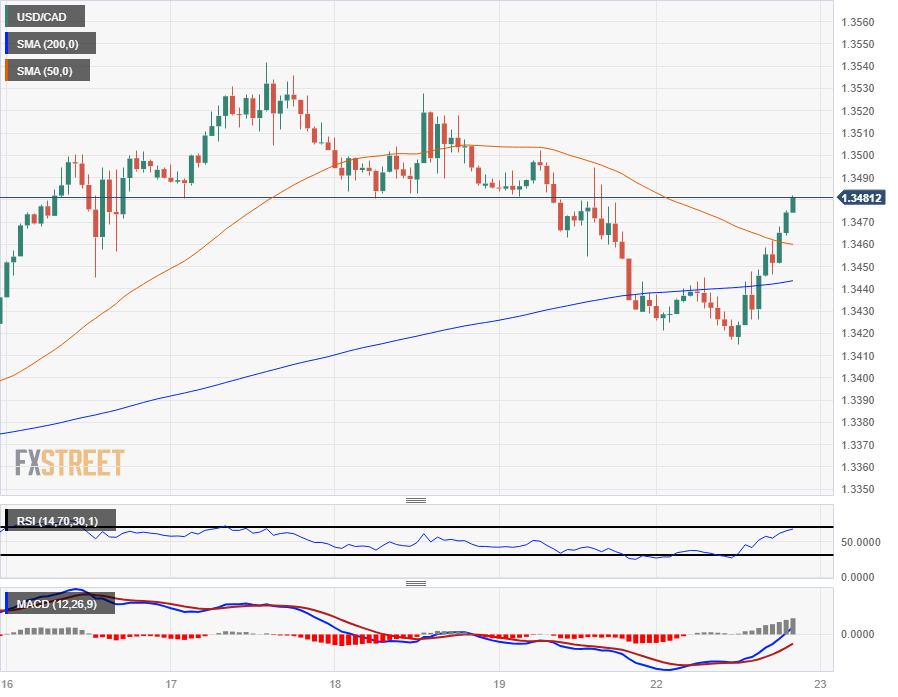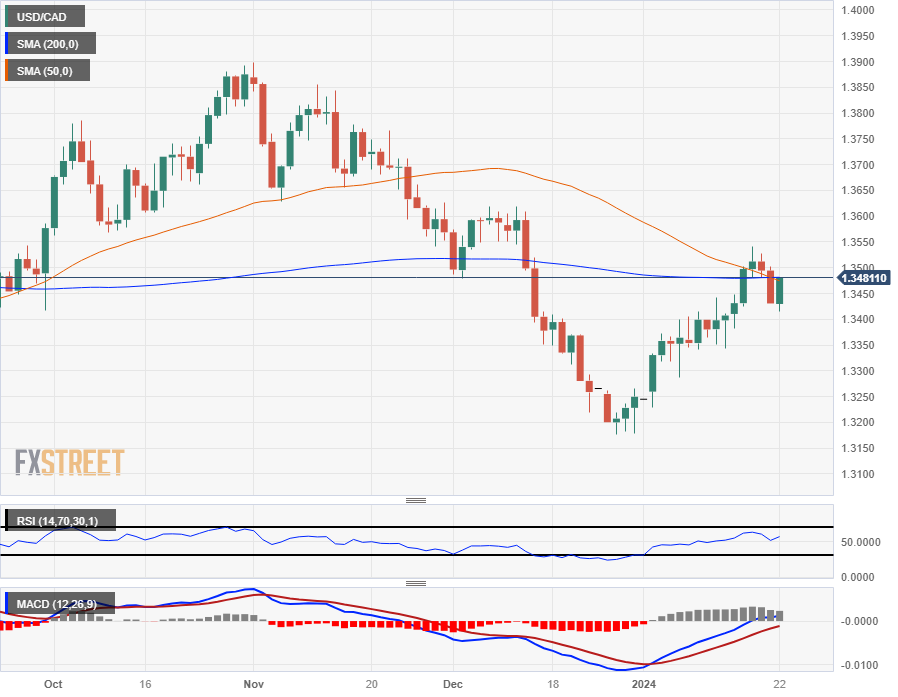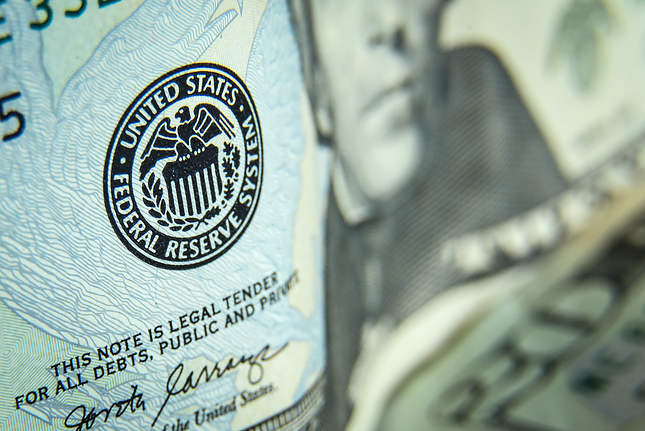- Canadian Dollar markets flatten out in quiet Monday trading.
- Canada New Housing Price Index due Tuesday, BoC lands Wednesday.
- Churning Crude Oil markets limit CAD losses.
The Canadian Dollar (CAD) saw thin action on Monday to kick off the trading week with limited momentum across the major currency board before a late plunge against the US Dollar (USD). CAD traders will be looking ahead to Wednesday’s rate call from the Bank of Canada (BoC), and markets are set for a blustery Friday to end the week with a fresh print of the US Personal Consumption Expenditure (PCE) Price Index.
The latest New Housing Price Index figures from Canada are due in the early US session on Tuesday but are expected to have a limited impact. In the meantime, downside pressure on the Canadian Dollar is limited on Monday as the Crude Oil market retests higher levels.
Daily digest market movers: Canadian Dollar mostly flat in thin Monday action
- The Canadian Dollar had a notable lack of momentum on Monday before extending into near-term losses against most of its peers.
- Markets are treading softly to kick off the new trading week but sticking close to the high end after US stocks hit all-time record prices last Friday.
- The Bank of Canada is broadly expected to hold rates steady at 5%, and investors will keep a close eye on the press conference to follow.
- According to a poll by Reuters, 22 of 34 surveyed economists see the first rate cut from the BoC to happen in June, with the remaining 12 calling for April.
- Back in December, swap markets were pricing in a 60% chance of a first rate cut from the BoC in March. Markets have since broadly pivoted their rate forecasts further out.
- This week sees rate calls from three central banks, but market sentiment is set to hinge on press conferences and central bank statements with broad-market hopes of early rate cuts thoroughly disappointed in recent weeks.
- Crude Oil markets continue to bid into recent highs, keeping the Canadian Dollar aloft.
- Geopolitical concerns see Crude Oil bids remaining elevated, but buildups in refined products are getting difficult to ignore as the global demand outlook for fossil fuels begins to wither.
Canadian Dollar price today
The table below shows the percentage change of Canadian Dollar (CAD) against listed major currencies today. Canadian Dollar was the strongest against the New Zealand Dollar.
| USD | EUR | GBP | CAD | AUD | JPY | NZD | CHF | |
| USD | 0.07% | -0.06% | 0.34% | 0.35% | -0.04% | 0.65% | 0.03% | |
| EUR | -0.07% | -0.13% | 0.26% | 0.28% | -0.12% | 0.58% | -0.02% | |
| GBP | 0.07% | 0.14% | 0.40% | 0.42% | 0.03% | 0.72% | 0.11% | |
| CAD | -0.34% | -0.26% | -0.39% | 0.00% | -0.38% | 0.33% | -0.29% | |
| AUD | -0.35% | -0.28% | -0.41% | 0.00% | -0.40% | 0.30% | -0.30% | |
| JPY | 0.05% | 0.11% | 0.02% | 0.38% | 0.38% | 0.71% | 0.09% | |
| NZD | -0.65% | -0.59% | -0.72% | -0.33% | -0.31% | -0.70% | -0.63% | |
| CHF | -0.03% | 0.03% | -0.10% | 0.30% | 0.31% | -0.09% | 0.60% |
The heat map shows percentage changes of major currencies against each other. The base currency is picked from the left column, while the quote currency is picked from the top row. For example, if you pick the Euro from the left column and move along the horizontal line to the Japanese Yen, the percentage change displayed in the box will represent EUR (base)/JPY (quote).
Technical Analysis: Canadian Dollar treads water on Monday, USD/CAD cycling near 1.3450
The Canadian Dollar (CAD) was flat against the Australian Dollar (AUD) on Monday and saw moderate gains against the day's weakest currency the New Zealand Kiwi (NZD), but falling against the rest of the major currencies, declining between a quarter and a third of a percent against the US Dollar, the Pound Sterling (GBP)< and the Japanese Yen (JPY).
The USD/CAD got tangled up on the 200-hour Simple Moving Average (SMA) on the intraday chart as the pair continued to find reasons to stick close to the 1.34500 region before a late-Monday launch back into near-term highs near 1.3500.
On the daily candlesticks, the USD/CAD is still at risk of consolidation following a bearish rejection from technical congestion at the 50-day and 200-day SMAs just below 1.3500, and near-term risks are pointed firmly to the downside.
On the high side, the USD/CAD is poised for a fresh run at last November’s peak near 1.3900 if near-term bullish momentum extends beyond last week’s swing high into 1.3550.
USD/CAD Hourly Chart
USD/CAD Daily Chart
Canadian Dollar FAQs
What key factors drive the Canadian Dollar?
The key factors driving the Canadian Dollar (CAD) are the level of interest rates set by the Bank of Canada (BoC), the price of Oil, Canada’s largest export, the health of its economy, inflation and the Trade Balance, which is the difference between the value of Canada’s exports versus its imports. Other factors include market sentiment – whether investors are taking on more risky assets (risk-on) or seeking safe-havens (risk-off) – with risk-on being CAD-positive. As its largest trading partner, the health of the US economy is also a key factor influencing the Canadian Dollar.
How do the decisions of the Bank of Canada impact the Canadian Dollar?
The Bank of Canada (BoC) has a significant influence on the Canadian Dollar by setting the level of interest rates that banks can lend to one another. This influences the level of interest rates for everyone. The main goal of the BoC is to maintain inflation at 1-3% by adjusting interest rates up or down. Relatively higher interest rates tend to be positive for the CAD. The Bank of Canada can also use quantitative easing and tightening to influence credit conditions, with the former CAD-negative and the latter CAD-positive.
How does the price of Oil impact the Canadian Dollar?
The price of Oil is a key factor impacting the value of the Canadian Dollar. Petroleum is Canada’s biggest export, so Oil price tends to have an immediate impact on the CAD value. Generally, if Oil price rises CAD also goes up, as aggregate demand for the currency increases. The opposite is the case if the price of Oil falls. Higher Oil prices also tend to result in a greater likelihood of a positive Trade Balance, which is also supportive of the CAD.
How does inflation data impact the value of the Canadian Dollar?
While inflation had always traditionally been thought of as a negative factor for a currency since it lowers the value of money, the opposite has actually been the case in modern times with the relaxation of cross-border capital controls. Higher inflation tends to lead central banks to put up interest rates which attracts more capital inflows from global investors seeking a lucrative place to keep their money. This increases demand for the local currency, which in Canada’s case is the Canadian Dollar.
How does economic data influence the value of the Canadian Dollar?
Macroeconomic data releases gauge the health of the economy and can have an impact on the Canadian Dollar. Indicators such as GDP, Manufacturing and Services PMIs, employment, and consumer sentiment surveys can all influence the direction of the CAD. A strong economy is good for the Canadian Dollar. Not only does it attract more foreign investment but it may encourage the Bank of Canada to put up interest rates, leading to a stronger currency. If economic data is weak, however, the CAD is likely to fall.
Information on these pages contains forward-looking statements that involve risks and uncertainties. Markets and instruments profiled on this page are for informational purposes only and should not in any way come across as a recommendation to buy or sell in these assets. You should do your own thorough research before making any investment decisions. FXStreet does not in any way guarantee that this information is free from mistakes, errors, or material misstatements. It also does not guarantee that this information is of a timely nature. Investing in Open Markets involves a great deal of risk, including the loss of all or a portion of your investment, as well as emotional distress. All risks, losses and costs associated with investing, including total loss of principal, are your responsibility. The views and opinions expressed in this article are those of the authors and do not necessarily reflect the official policy or position of FXStreet nor its advertisers. The author will not be held responsible for information that is found at the end of links posted on this page.
If not otherwise explicitly mentioned in the body of the article, at the time of writing, the author has no position in any stock mentioned in this article and no business relationship with any company mentioned. The author has not received compensation for writing this article, other than from FXStreet.
FXStreet and the author do not provide personalized recommendations. The author makes no representations as to the accuracy, completeness, or suitability of this information. FXStreet and the author will not be liable for any errors, omissions or any losses, injuries or damages arising from this information and its display or use. Errors and omissions excepted.
The author and FXStreet are not registered investment advisors and nothing in this article is intended to be investment advice.
Recommended content
Editors’ Picks

AUD/USD holds steady near 0.6250 ahead of RBA Minutes
The AUD/USD pair trades on a flat note around 0.6250 during the early Asian session on Monday. Traders brace for the Reserve Bank of Australia Minutes released on Tuesday for some insight into the interest rate outlook.

USD/JPY consolidates around 156.50 area; bullish bias remains
USD/JPY holds steady around the mid-156.00s at the start of a new week and for now, seems to have stalled a modest pullback from the 158.00 neighborhood, or over a five-month top touched on Friday. Doubts over when the BoJ could hike rates again and a positive risk tone undermine the safe-haven JPY.

Gold price bulls seem non-committed around $2,620 amid mixed cues
Gold price struggles to capitalize on last week's goodish bounce from a one-month low and oscillates in a range during the Asian session on Monday. Geopolitical risks and trade war fears support the safe-haven XAU/USD. Meanwhile, the Fed's hawkish shift acts as a tailwind for the elevated US bond yields and a bullish USD, capping the non-yielding yellow metal.

Week ahead: No festive cheer for the markets after hawkish Fed
US and Japanese data in focus as markets wind down for Christmas. Gold and stocks bruised by Fed, but can the US dollar extend its gains? Risk of volatility amid thin trading and Treasury auctions.

Bank of England stays on hold, but a dovish front is building
Bank of England rates were maintained at 4.75% today, in line with expectations. However, the 6-3 vote split sent a moderately dovish signal to markets, prompting some dovish repricing and a weaker pound. We remain more dovish than market pricing for 2025.

Best Forex Brokers with Low Spreads
VERIFIED Low spreads are crucial for reducing trading costs. Explore top Forex brokers offering competitive spreads and high leverage. Compare options for EUR/USD, GBP/USD, USD/JPY, and Gold.